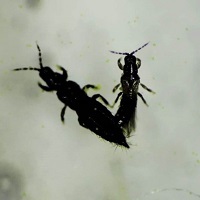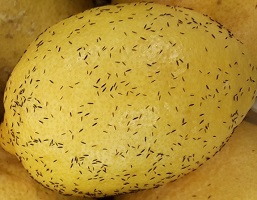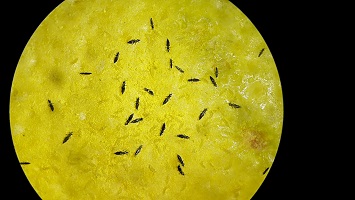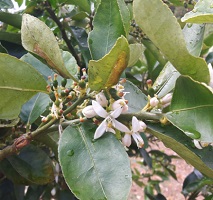Doctor Alihan Katlav
Candidature
Graduated PhD 2022
Thesis Title
Sex allocation in Kelly's citrus thrips, Pezothrips kellyanus: mechanisms, constraints and the role of endosymbionts
Research Project
 Recent advances in insect microbiology have opened new avenues for biological control of insect pests. Understanding the biological roles of microbial communities in insects and deciphering their ecological and evolutionary impact on host populations may increase the success rate of insect biological control programs. Wolbachia is the most common insect associated microbe. It is a maternally inherited endosymbiotic bacterium that can manipulate the reproductive biology of its host, and it is therefore also known as a reproductive parasite. Cardinium is another common bacterial reproductive parasite of insects. The most frequent reproductive manipulation induced by these bacteria, cytoplasmic incompatibility (CI), is a crossing sterility between individuals of different infection status, and this leads to embryonic mortality of eggs.
Recent advances in insect microbiology have opened new avenues for biological control of insect pests. Understanding the biological roles of microbial communities in insects and deciphering their ecological and evolutionary impact on host populations may increase the success rate of insect biological control programs. Wolbachia is the most common insect associated microbe. It is a maternally inherited endosymbiotic bacterium that can manipulate the reproductive biology of its host, and it is therefore also known as a reproductive parasite. Cardinium is another common bacterial reproductive parasite of insects. The most frequent reproductive manipulation induced by these bacteria, cytoplasmic incompatibility (CI), is a crossing sterility between individuals of different infection status, and this leads to embryonic mortality of eggs.
CI has attracted attention in fundamental and applied research, as it impacts host ecology and evolution, but also can be applied in biological control of insects by suppressing uninfected field populations through the release of infected males – a strategy known as incompatible insect technique (IIT). So far IIT has only been developed and tested for control of some diplodiploid pest insects.
Kelly’s citrus thrips (Pzothrips kellyanus) of the haplodiploid order of Thysanoptera is an economically important pest of citrus native to Australia and invasive to New Zealand and the Mediterranean region. Previous research has demonstrated that populations of its native range are infected with both Cardinium and Wolbachia. However, populations from New Zealand and the Mediterranean region only have Cardinium. Both bacteria induce CI in this host species.
In this PhD project I aim to investigate the influence of Wolbachia and Cardinium on the reproductive biology, resource allocation and sperm competition of P. kellyanus. This will provide important information for the development and testing of endosymbiont-based IIT for this haplodiploid thrips species.
Research Images




A) Mating behaviour of Kelly’s citrus thrips. B-C) Colony of Kelly’s citrus thrips on surface of lemon skin. D) Lemon flowers infested with Kelly’s citrus thrips (Photos: Alihan Katlav)
Research supervisors
A/Professor Markus Riegler and Professor James Cook
Awards and recognition
- F.G Swain Award (2018) Hawkesbury Foundation (Western Sydney University) ($11220)
- John Henry Comstock Award (2020) (International Branch) - Entomological Society of America
Publications
Katlav A, Cook JM, Riegler M, (2022) 'Common endosymbionts affect host fitness and sex allocation via egg size provisioning', Proceedings of the Royal Society B: Biological Sciences, vol.289, no.1971, Article no.20212582
Katlav A, Nguyen DT, Morrow JL, Spooner-Hart RN, Riegler M, (2022) 'Endosymbionts moderate constrained sex allocation in a haplodiploid thrips species in a temperature-sensitive way', Heredity, vol.128, no.3, pp 169 - 177
Khadem-Safdarkhani H, Hajiqanbar H, Riegler M, Seeman O, Katlav A, (2022) 'Two New Phoretic Species of Heterostigmatic Mites (Acari: Prostigmata: Neopygmephoridae and Scutacaridae) on Australian Hydrophilid Beetles (Coleoptera: Hydrophilidae)', Insects, vol.13, no.5, Article no.483
Katlav A, Cook JM, Riegler M, (2021) 'Egg size-mediated sex allocation and mating-regulated reproductive investment in a haplodiploid thrips species', vol.35, no.2, pp 485-498
Katlav A, Hajiqanbar H, Riegler M, Seeman OD, (2021) 'Sheltered life beneath elytra: three new species of Eutarsopolipus (Acari, Heterostigmatina, Podapolipidae) parasitizing Australian ground beetles', Parasite, vol.28, Article no.75
Katlav A, Nguyen DT, Cook JM, Riegler M, (2021) 'Constrained sex allocation after mating in a haplodiploid thrips species depends on maternal condition', Evolution, vol.75, no.6, pp 1525-1536
Katlav A, Riegler M, Seeman OD, (2020) 'Tiny hitchhikers and parasites: a review of Australian heterostigmatic mites (Acari: Prostigmata) associated with insects, with description of three new species', Austral Entomology, vol.59, no.3, pp 401-421
Katlav A, Hajiqanbar H, (2018) 'First description of male and larval female of parasitic mite Eutarsopolipus abdominis (Acari: Podapolipidae) with redescription of the adult female', The Journal of Parasitology, vol.104, no.1, pp 1-9
Katlav A, Hajiqanbar H, Talebi AA, (2016) 'Two remarkable new species of the superfamily Pygmephoroidea (Acari: Heterostigmata) associated with beetles (Coleoptera: Carabidae, Staphylinidae)', Annals of the Entomological Society of America, vol.109, pp 136-144
Katlav A, Hajiqanbar H, Talebi AA, (2015) 'First record of the genus Aethiophenax (Acari: Acarophenacidae) from Asia, redefinition of the genus and description of a new species', Asia-Pacific Entomology, vol.18, pp 389-395
Katlav A, Hajiqanbar H, Talebi AA, (2015) 'A new genus and species of mites of the family Caraboacaridae (Acari: Heterostigmata) associated with Clivina ypsilon (Coleoptera: Carabidae) with notes on distribution and host range of the family', Canadian Entomologist, vol.147, pp 370-38
Katlav A, Hajiqanbar H, Talebi AA, (2015) 'Pseudopygmephorellus mazandaranicus sp. nov. (Acari: Heterostigmata: Pygmephoridae), phoretic on scarabaeid dung beetles (Coleoptera: Scarabaeidae) from Iran', Zootaxa, vol.3919, pp 100-110
Katlav A, Hajiqanbar H, Talebi AA, (2015) 'A contribution to the knowledge of heterostigmatic mites (Acari: Prostigmata) in western Mazandaran Province, Northern Iran', Acarologia, vol.55, pp 311-320
Katlav A, Hajiqanbar H, Talebi AA, (2014) 'Dorsipes caspius n. sp. (Acari: Podapolipidae), a subelytral parasite of Pterostichus caspius (Menetries) (Coleoptera: Carabidae) with notes on host range of the genus and the distribution of the platysmae group', Systematic Parasitology, vol.89, pp 117-132
Katlav A, Hajiqanbar H, Talebi AA, (2014) 'First record of the genus Acanthomastix Mahunka, 1972 (Acari: Dolichocybidae) from Asia, with the description of a new species', International journal of acarology, vol.40, no.1, pp 7-14